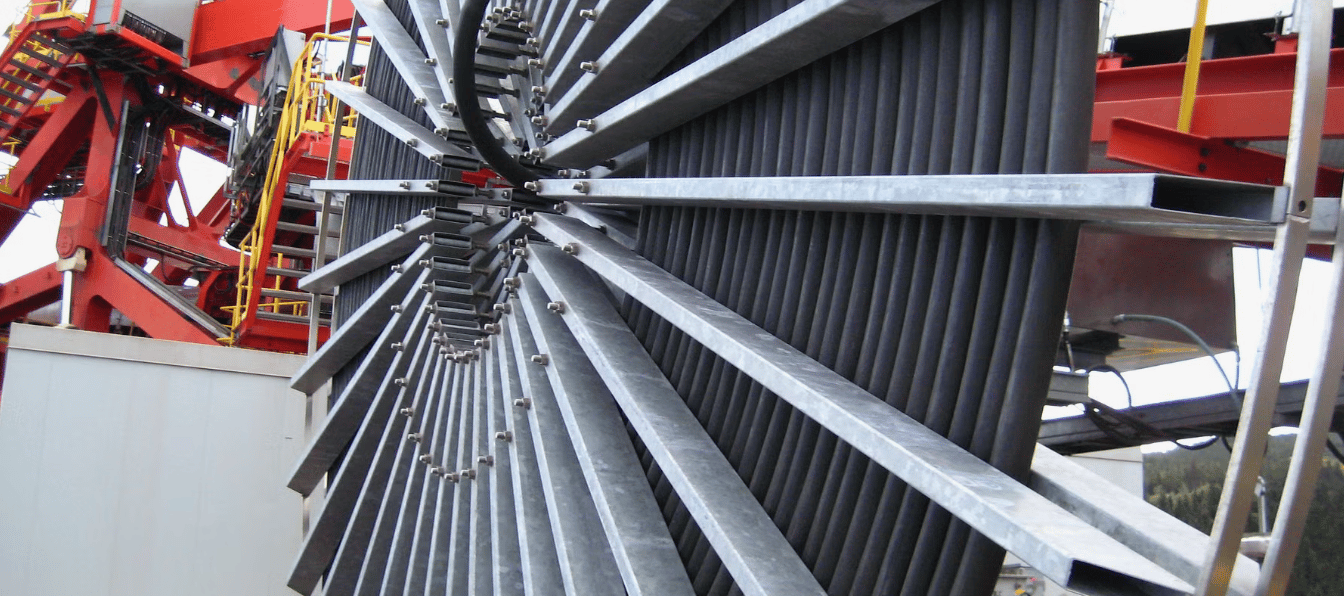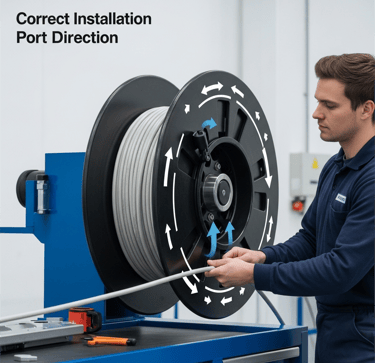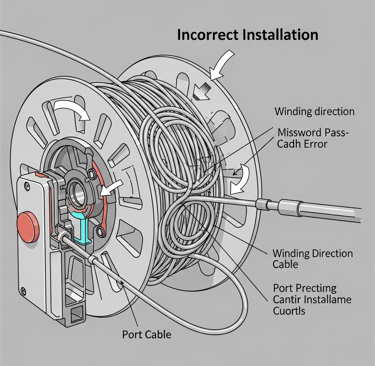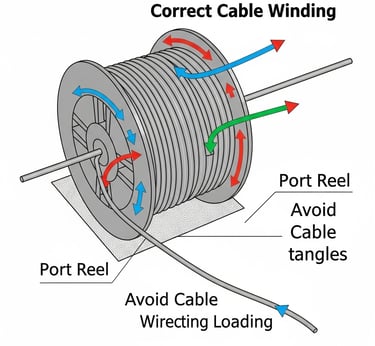📞+86 153 7530 2641 📧 hongjing.Wang@feichuncables.com
Choosing and Installing Reeling Cables for Port Cranes
Explore expert guidelines on selecting and installing reeling cables for port cranes. Learn best practices for marine-grade reeling systems and port cable installation.
hongjing.Wang@Feichun
7/11/20258 min read
Introduction: Why Proper Cable Selection & Installation Matters for Australian Port Operations
Australia's bustling ports, from Melbourne to Sydney and beyond, handle millions of containers annually, relying on sophisticated crane systems that demand robust electrical infrastructure. The harsh marine environment presents unique challenges that make proper cable selection and installation absolutely critical for maintaining operational efficiency and safety standards.
Port equipment cables face relentless exposure to salt spray, UV radiation, extreme temperatures, and constant mechanical stress from crane movements. When improper cables are selected or incorrectly installed, the consequences extend far beyond simple equipment failure. Australian port operators have witnessed costly downtime, cargo delays, and safety incidents directly attributable to cable failures, with some incidents resulting in losses exceeding hundreds of thousands of dollars per day.
The importance of using correct reeling cables cannot be overstated. These specialised cables serve as the lifeline for port cranes, delivering power and control signals that enable precise container handling operations. When properly selected and installed, quality reeling cables significantly improve operational lifespan, reduce maintenance costs, and enhance workplace safety – factors that directly impact Australia's position as a global shipping hub.


What Are Reeling Cables and Why Are They Essential in Port Cranes?
Reeling cables represent a specialised category of electrical cables engineered specifically for dynamic applications where continuous winding and unwinding occur. Unlike standard fixed installation cables, reeling cables feature unique construction characteristics that enable them to withstand the constant mechanical stress associated with crane operations.
The fundamental structure of reeling cables incorporates several critical design elements. High-grade copper conductors provide superior electrical conductivity and flexibility, while specialised insulation materials resist moisture ingress and temperature fluctuations. The cable sheath, typically constructed from polyurethane or rubber compounds, offers exceptional resistance to abrasion, chemical exposure, and UV degradation – essential properties for Australian port environments.
Port cranes utilise these cables across various applications, including quay cranes that transfer containers from ships to shore, rubber-tyred gantry cranes (RTGs) that move containers within storage yards, and ship-to-shore cranes (STSs) that handle the largest container vessels. Each application demands specific cable characteristics, from power transmission capabilities to signal integrity requirements.
The flexible design of reeling cables allows for smooth operation around cable drums and reels, accommodating the continuous motion required for crane positioning and load handling. This flexibility, combined with superior torsion resistance, enables thousands of operational cycles without degradation – a critical factor for maintaining Australia's competitive port throughput rates.
How to Select the Right Marine-Grade Reeling Cable for Port Applications
Selecting appropriate reeling cables for port applications requires careful consideration of multiple technical parameters that directly impact performance and longevity. Current carrying capacity stands as the primary selection criterion, as insufficient capacity can lead to overheating, insulation breakdown, and catastrophic failure during critical operations.
Corrosion resistance becomes particularly crucial in Australian port environments, where salt spray and humidity create challenging conditions for electrical equipment. Marine-grade reeling cables incorporate specialised sheath materials and sealing technologies that prevent moisture ingress and resist chemical degradation from salt exposure and industrial pollutants.
Mechanical strength requirements encompass both tensile strength and torsion resistance. Port cranes subject cables to significant mechanical loads during operation, including tension forces from cable weight and dynamic loads from crane acceleration and deceleration. Torsion resistance proves equally important, as cables must withstand twisting forces without internal conductor damage or sheath cracking.
Understanding manufacturer parameter tables becomes essential for proper selection. These documents specify critical values including maximum tension limits, allowable torsion cycles, and minimum bending radius requirements. Australian port operators should pay particular attention to temperature ratings, ensuring selected cables can operate reliably in ambient conditions ranging from winter lows to summer extremes exceeding 40°C.
Environmental certifications provide additional selection guidance, with IP ratings indicating ingress protection levels and UV resistance specifications confirming suitability for outdoor applications. Marine-grade cables typically feature enhanced UV stabilisation and ozone resistance, essential for Australia's intense solar exposure conditions.
Step-by-Step Guide to Proper Reeling Cable Installation for Port Cranes
Proper reeling cable installation requires meticulous attention to manufacturer specifications and industry best practices. The installation process begins with careful cable routing from the supply reel, ensuring adequate clearance for the cable's natural curvature and avoiding sharp edges or abrasive surfaces that could damage the sheath.
Cable securing methods play a crucial role in installation success. Kellem grips, also known as cable socks, provide distributed strain relief by gripping the cable sheath over an extended length, preventing localised stress concentrations that could lead to premature failure. Large-surface clamps offer additional support for heavier cables, distributing mechanical loads across broader contact areas.
Tension management represents a critical installation parameter. Excessive tension during installation can stretch conductors beyond their elastic limits, creating permanent damage that manifests as increased resistance and reduced current carrying capacity. Conversely, insufficient tension can result in cable slack that may cause entanglement or mechanical damage during operation.
Bending radius requirements demand strict adherence to manufacturer specifications. Excessive bending creates stress concentrations within conductor strands and insulation materials, leading to accelerated degradation and potential failure. Installation teams must use proper cable guides and supports to maintain specified minimum bending radii throughout the cable run.
Winding direction proves fundamental to cable longevity. Cables manufactured with Z-lay construction must be wound in the corresponding direction to prevent internal stress buildup. Incorrect winding direction creates torsional stress that accumulates over operational cycles, eventually causing conductor breakage or sheath cracking. Understanding and identifying proper lay direction requires careful examination of cable construction and consultation with manufacturer documentation.






Common Installation Mistakes and How to Avoid Them in Australian Port Environments
Several installation errors frequently occur in port crane applications, each carrying significant consequences for operational reliability and safety. Wrong winding direction represents perhaps the most common mistake, often resulting from inadequate training or misunderstanding of cable construction principles. This error creates internal torsional stress that accelerates wear and reduces operational life by up to 50%.
Insufficient bending radius commonly occurs when installers attempt to route cables through tight spaces or around inadequate support structures. This mistake creates stress concentrations that propagate through the cable structure, eventually causing insulation breakdown or conductor failure. The effects may not manifest immediately but accumulate over time, leading to unexpected failures during critical operations.
Excessive installation tension represents another frequent error, particularly when using mechanical pulling equipment. Over-tensioning stretches conductors beyond their elastic limits, creating permanent deformation that increases electrical resistance and reduces current carrying capacity. This condition often remains undetected until thermal imaging reveals elevated operating temperatures or electrical testing identifies increased resistance values.
Inadequate cable support during installation can result in mechanical damage from contact with sharp edges, abrasive surfaces, or other equipment. Port environments contain numerous potential damage sources, from steel structures to container handling equipment, requiring careful planning and protection during installation activities.
The long-term impacts of these installation errors extend beyond simple cable replacement costs. Premature failures can result in crane downtime during peak operational periods, cargo delays, and potential safety incidents. Australian port operators have reported single cable failures resulting in daily losses exceeding $100,000 due to reduced throughput capacity and customer penalties.
Maintenance Tips to Extend Cable Lifespan in Marine Port Environments
Effective maintenance strategies significantly extend reeling cable lifespan while reducing unexpected failure risks. Regular inspection schedules should encompass visual examination of cable condition, tension monitoring, and assessment of winding characteristics. These inspections help identify potential issues before they progress to failure conditions.
Tension monitoring proves particularly important for maintaining optimal cable performance. Excessive tension accelerates wear on both the cable and associated mechanical components, while insufficient tension can result in cable slack that creates entanglement risks. Proper tension levels ensure smooth operation while minimising mechanical stress on cable components.
Winding condition assessment involves examining cable lay on the drum or reel, identifying any irregular patterns that might indicate developing problems. Proper winding maintains consistent spacing between cable layers, preventing crossover conditions that create localised stress concentrations. Irregular winding patterns often indicate alignment issues or mechanical wear in the winding mechanism.
Protective measures against environmental hazards play a crucial role in cable longevity. Port environments expose cables to various contaminants, from salt spray to industrial chemicals and particulate matter. Regular cleaning and application of appropriate protective coatings help maintain cable integrity and prevent accelerated degradation.
Operational practices significantly impact cable lifespan. Maintaining at least two complete turns on the cable reel prevents over-unwinding conditions that can damage cable terminations and create safety hazards. Avoiding complete unwinding also ensures consistent drum diameter for proper winding geometry throughout the operational range.
Why Choose a Trusted Supplier for Reeling Cables in Australian Port Operations
Professional manufacturers offer significant advantages over generic cable suppliers, particularly for critical port applications where reliability directly impacts operational efficiency. Established manufacturers provide comprehensive technical support, including application-specific design recommendations and installation guidance tailored to Australian port conditions.
Product certifications provide assurance of quality and compliance with relevant standards. International certifications such as DIN VDE, IEC, and RoHS demonstrate manufacturer commitment to quality and environmental responsibility. These certifications become particularly important for Australian ports serving international shipping lines with specific equipment requirements.
Customisation capabilities enable suppliers to tailor cable specifications to specific port requirements. This flexibility proves valuable when standard products cannot accommodate unique installation constraints or performance requirements. Custom solutions may incorporate specialised sheath materials, modified conductor configurations, or enhanced environmental protection features.
Technical support services extend beyond simple product supply to encompass installation guidance, troubleshooting assistance, and ongoing maintenance recommendations. This support proves particularly valuable for complex installations or when integrating new cables with existing systems. Local technical support reduces response times and ensures familiarity with Australian port operating conditions.
Quality assurance programs provide traceability and performance verification throughout the manufacturing process. Comprehensive testing protocols ensure each cable meets specified performance criteria before delivery, reducing the risk of field failures and associated operational disruptions.
Frequently Asked Questions About Reeling Cable Installation
Q: How do I determine the correct winding direction for my reeling cables? A: Cable winding direction depends on the cable's lay construction. Z-lay cables wind clockwise when viewed from the drum end, while S-lay cables wind counter-clockwise. Check the manufacturer's documentation or examine the cable construction to identify the correct lay direction.
Q: What's the minimum bending radius for marine-grade reeling cables? A: Minimum bending radius varies by cable construction and diameter, typically ranging from 10 to 20 times the cable diameter. Always consult manufacturer specifications for exact requirements, as exceeding these limits can cause permanent damage.
Q: How often should I inspect reeling cables in port crane applications? A: Monthly visual inspections are recommended for active port cranes, with detailed mechanical and electrical testing performed quarterly. High-usage cranes may require more frequent inspection intervals.
Q: Can I repair damaged reeling cables, or must they be replaced entirely? A: Minor sheath damage may be repairable using appropriate techniques and materials, but conductor damage typically requires complete replacement. Consult with qualified technicians to assess repair feasibility and safety implications.
Get Expert Cable Consultation for Your Port Operations Today
Proper reeling cable selection and installation requires expertise that directly impacts your port's operational efficiency and safety performance. Don't risk costly downtime or safety incidents with inadequate cable solutions.
Our technical specialists offer comprehensive consultation services, including site assessments, application-specific recommendations, and detailed installation guidance. We provide customised solutions that meet Australian port operating conditions while ensuring compliance with relevant safety standards.
Contact us today for a free cable consultation and discover how proper reeling cable selection can improve your port's operational reliability. Download our comprehensive installation guide or request a detailed quote for your specific requirements.
How to Reach Us
Get in Touch
SiteMap
Product Catalogue
Reeling Cable
Festoon Cable
Shore Power Cable




Scan to add us on WeChat
